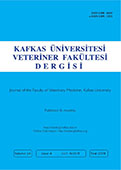
This journal is licensed under a Creative Commons Attribution-NonCommercial 4.0 International License
Kafkas Üniversitesi Veteriner Fakültesi Dergisi
2018 , Vol 24 , Issue 4
The First Molecular Detection and Genotyping of Encephalitozoon cuniculi in Rabbit's Eye in Turkey
1Çankırı Karatekin University, Faculty of Science, Department of Biology, TR-18100 Çankırı - TURKEY2Public Health General Directorate, Parasitology Laboratory, TR-06100 Ankara - TURKEY
3Selcuk University, Faculty of Medicine, Department of Medical Genetic, TR-42130 Konya - TURKEY
4Kırıkkale University, Faculty of Veterinary Medicine, Department of Pathology, 71450, Ankara - TURKEY DOI : 10.9775/kvfd.2018.19696 Encephalitozoon cuniculi was first recognized as the disease agent in rabbits in 1922. The genotype of E. cuniculi isolated from laboratory rabbits with the neurologic disease was described as genotype I. In the eye, this parasite causes damage to the lens, causing phacoclastic uveitis and cataracts. Intraocular infection often occurs in cases of transplacental transmission. There has been no report on the molecular diagnosis of the parasite in Turkey. The current study is the first report on the detection of E. cuniculi spores using the molecular method in Turkey. In our previous study, a rabbit breeding facility was determined seropositive for E. cuniculi infection monitored for five years in terms of clinical symptoms. An autopsy was performed for a definite diagnosis of the infection. Samples were stained according to the hematoxylin-eosin (H&E) staining after tissue processing procedure and histopathologic analysis was performed. In addition to, the samples for DNA extraction were also taken during the autopsy. ECUNF and ECUNR species-specific primer pairs were used for amplification and genotyping of E. cuniculi. The animals were observed no clinical symptoms except ocular lesion (n=9). Therefore, one of these rabbits was used in the autopsy to definite diagnosis and determination of the damage to the eye. As histopathological, the lesions in the eye were found in the initial or middle stage of progressive infection. The DNA sequence showed that E. cuniculi examined in the present study were genotype I. Possible cause of the visible white mass in the rabbit"s eye may be the parasite infection. Therefore, clinicians may consider E. cuniculi as one of the possible causes of ocular lesions in rabbits during daily inspection or ophthalmological examination. Keywords : Rabbit, Eye, Molecular diagnosis, Encephalitozoon cuniculi, Phylogenetic analysis, Turkey










